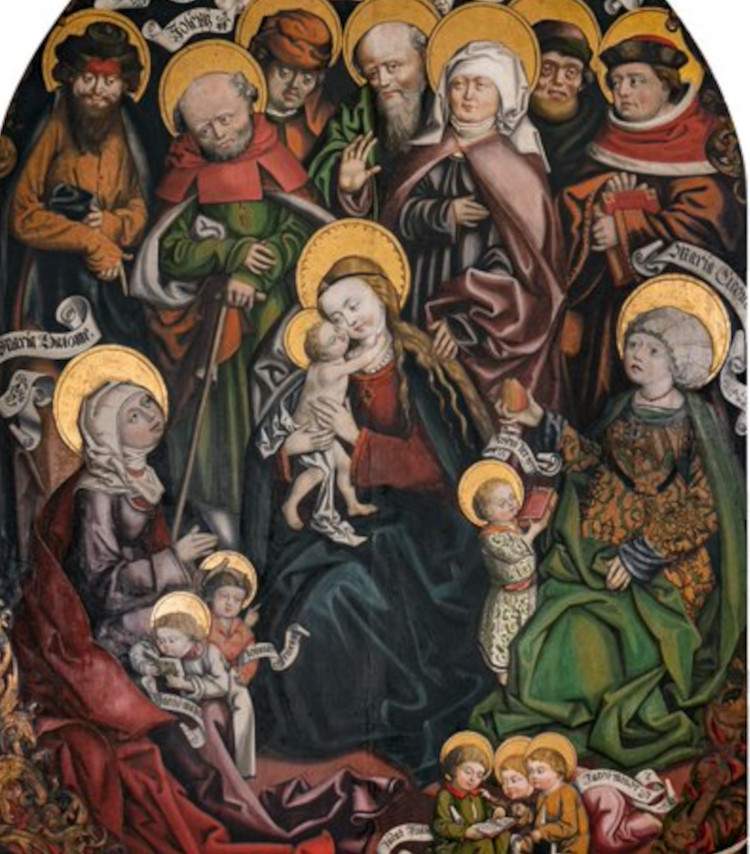The different faces of Saint Anne, from emancipated woman to aged and ugly. In Trent, an exhibition on the theme
An iconographic exhibition, entitled Anna, the Mother of Mary, is on display in the halls of the Tridentine Diocesan Museum until December 10, 2021. Cult and Iconography in the Historic Tyrol, curated by Alessandra Galizzi Kroegel and Stefanie Paulmichl of the University of Trent, which illustrates to the public how the representation of Anna, whom tradition considers the mother of Mary and grandmother of Jesus, has changed over the centuries.
The exhibition is the result of research conducted by the two curators at theUniversity of Trent: in the late Middle Ages and particularly in the Renaissance period, the saint was a model of emancipation and success, then the image of Anne either disappeared altogether or was “tamed” in many different ways: aging her, making her ugly, relegating her to the background and eliminating her three husbands.
An elderly woman with a face marked by the weight of years; a reserved and somewhat weary grandmother contemplating her grandchild in silence; a mother with a meek and resigned air showing her daughter a prayer book: this is the most widespread image of Anna. Especially between the late Middle Ages and the Renaissance,in German circles, she was depicted by artists as a determined woman who had had three husbands and two widowhoods, three daughters and seven grandchildren, who exercised her authority both in the family and in society, so much so that she was a model of emancipation and success for the bourgeoisie.
“Anna is a figure of a woman who was too great, autonomous and important to be tolerated for long,” comments Alessandra Galizzi Kroegel. “The cult for St. Anne enjoyed enormous popularity among the upper classes, who liked the idea of a character whom legend wanted wealthy and at the head of a large and prestigious genealogy. Very soon, however, all this was attacked and censored first by the Reformation and then by the Counter-Reformation, so that Anna’s image disappeared altogether, or was ”tamed“ in many different ways: by aging her, making her ugly, relegating her to the background and above all by eliminating her three husbands.”
The exhibition is divided into three main sections with about 30 works including paintings, sculptures, engravings and photographs. It revolves around three iconographic types: the iconography known as Anna Metterza (German: Anna Selbdritt), the Sacred Kinship(Heilige Sippe) andMary’s Education or Anna teaches Mary to read(Die Unterweisung Mariens or Anna lehrt Maria das Lesen). The second section is entirely devoted to devotion to St. Anne in the episcopal principality of Trent, while in the third and final part of the exhibition the works on display mark the stages of the transformations undergone by the figure of Anne between the 16th and 18th centuries. The exhibition closes with the photo Education of the Virgin taken in Kabul in 2016 by Ugo Panella. The parallel with the similar iconography of St. Anne, particularly with the theme of Mary’s Education, is intended to stimulate reflection on the difficult relationship between women and religion.
The first part of the exhibition presents sculptures, doorway altars and painted panels from the early decades of the 16th century from Trentino-South Tyrol and southern Austria. Among the artists on display are the Meister der Habsburger, Jörg Arzt, and Marcello Fogolino. The second part, on the other hand, is narrated by several altarpieces by Jacopo Ligozzi, Carlo Pozzi, the Unterperger brothers, and a series of objects of popular devotion especially from the Trentino area, dating from the late 16th to the 18th century.
The catalog contains essays on hagiography, art history, ethno-anthropology and devotional/popular art. The exhibition is part of the initiatives of the Year of Euregio Museums 2021.
The exhibition is organized in collaboration with Tridentine Diocesan Archives, Center for Advanced Humanistic Studies (CeASUm) of the University of Trent, Museum of the Uses and Customs of the Trentino People, Diocesan Museum Bressanone - Hofburg, University of Trent, Department of Humanities. It is realized with the contribution of Cultural Activities Service of the Autonomous Province of Trento, Europaregion/Euregio | Tirol Südtirol Trentino/Tirol Alto Adige Trentino, Fondazione Caritro - Cassa di Risparmio di Trento e Rovereto.
For info: museodiocesanotridentino.it
Hours: Daily from 10 a.m. to 1 p.m. and 2 to 6 p.m. Closed Tuesdays.
Image: Paul Zwinger, Sacra Parentela (post 1498; tempera on panel, 186.5 x 136.5 cm; Brixen, Hofburg Diocesan Museum)
 |
| The different faces of Saint Anne, from emancipated woman to aged and ugly. In Trent, an exhibition on the theme |
Warning: the translation into English of the original Italian article was created using automatic tools. We undertake to review all articles, but we do not guarantee the total absence of inaccuracies in the translation due to the program. You can find the original by clicking on the ITA button. If you find any mistake,please contact us.




























